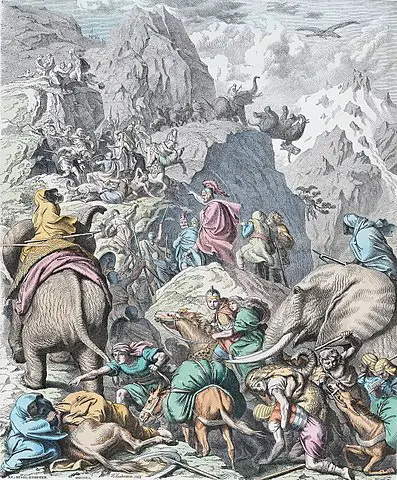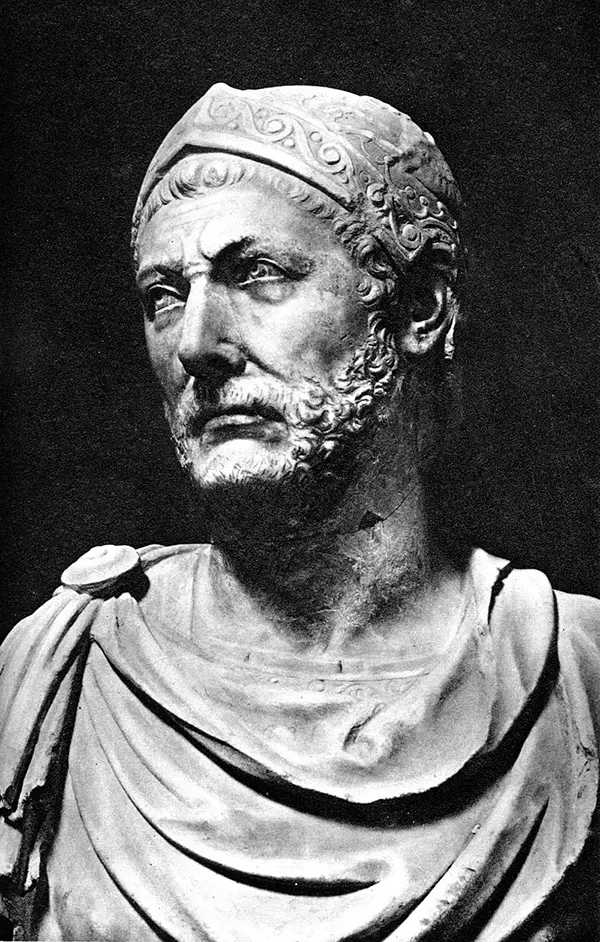Second Punic War
The Second Punic War took place between 218 B.C.E. through 201 B.C.E. The war was fought between the ancient Romans and the Carthaginians.
The leaders of both armies were masters of warfare. The Carthaginians were led by Hannibal, and the ancient Romans were influenced by Scipio Africanus. Although Carthage lost the war, the fighting took a tremendous toll on both parties.

How did the Second Punic War start?
After the First Punic War, the Carthaginians had lost all of their landholdings in Sicily. During the following years, the Carthaginians, under the command of Hamilcar Barca, the father of Hannibal, conquered lands in Hispania, which is in present-day Spain and Portugal. After the death of Hamilcar Barca, the Carthaginian army was led by Hasdrubal and then Hannibal.
Hannibal, known as the Beloved of Baal, had sworn hatred towards the ancient Romans. Under the rules of the First Punic War treaty, the Carthaginians were not to go north of the Ebro River. When Hannibal came close to crossing the Ebro River, the Saguntines provoked Hannibal by massacring pro-Carthaginians within their cities.
This was a problem for the Romans because they had no support pact signed with tribes south of Ebro River. After Hannibal campaigned against the Saguntines, the ancient Romans wanted the Carthaginian senate to give Hannibal to the Romans. They refused, and the two entities went to war again.
Battles fought in Italy
The ancient Romans attacked Carthage while Hannibal was still in Hispania, also known as Iberia. Hannibal knew that something needed to be done to stop the Roman advance on Carthage.
He decided that he would do the unthinkable at the time and cross the Alps and took his army of 40,000 soldiers through present-day southern France and proceeded to cross the steep mountain range.
Along with his army, he took 37 war elephants to transport goods, men, and other necessary items needed to rage war on the ancient Romans.
The Alps took a toll on the Carthaginian army and Hannibal’s war elephants. When he finally entered the Italian peninsula, his army had been cut in half, and only three of the war elephants survived the harsh climate while crossing the steep snowy Alps.
The ancient Romans did not believe the Carthaginians would attack because they had no fleet to transport troops. Hannibal’s crossing over the Alps surprised the ancient Romans. No other army had ever tried such a tactic.

In the spring of 218 B.C.E., the ancient Romans attacked Hannibal in northern Italy. Hannibal fought back with the 26,000 soldiers that remained after crossing the Alps. Hannibal was victorious in defeating the Romans at the Ticinus River and the Battle of Trebia.
Unfortunately for Hannibal, his effort was not received well by the Gallic and northern Italian cities. Most of the Roman landholders had burned their estates so Hannibal could not plunder and use the land to feed his army. But none the less, Hannibal was able to increase his army to 50,000 soldiers.
The following year the Romans tried to ambush Hannibal near the city of Arretium. But Hannibal knew of the ambush beforehand. He bypassed the trap and continued his way toward Rome.
The Romans suffered another defeat at the Battle of Lake Trasimene, where they were ambushed by Hannibal and almost destroyed by the Carthaginians.
At this point, Hannibal did not want to lay siege on the city of Rome. His army lacked the equipment to siege the city and did not have the proper supply lines to replenish his troops. Instead, Hannibal went south to stir up trouble and possibly start a rebellion against Rome by the southern cities.
The Roman dictator at the time was Fabius Maximus. He decided not to engage directly with Hannibal’s army. Instead, he tried to further cut off the supply lines to Hannibal’s army by plundering the countryside.
Rome did not like this idea. Fabius Maximus was replaced, and the new leaders of the Roman military decided to fight Hannibal in 216 B.C.E. at the city of Cannae. The Romans had an army of 70,000 soldiers and Hannibal 50,000 men at the beginning of the battle.
After Hannibal had the center of his line retreat, he was able to encircle the Romans. Only 16,000 Roman soldiers lived after the Battle of Cannae.
Hannibal gained the support of several entities after Cannae, including Macedonia, Syracuse, Tarentum, and Capua. After the defeat, Fabius Maximus was put in charge again and started his tactics of plundering the countryside and harassing Hannibal’s army once again.
Iberia and Hispania
While Hannibal was fighting in Italy, his brother-in-law Hasdrubal had been engaged with the Romans in Iberia, also known as Hispania. In 211 B.C.E., Rome overtook Saguntum, Capua, and Syracuse, which withstood a two-year siege by using defense devices invented by Archimedes.
Eventually, Hasdrubal won against the Romans but still did not feel comfortable sending reinforcements to Hannibal in Italy.

In 210 B.C.E., the Romans sent Scipio Africanus to Iberia to confront Hasdrubal. At this point, the Romans attacked the port city of Carthago Nova, the capital of Iberia under Carthage. Scipio Africanus was successful in defeating Hasdrubal, who withdrew his forces and tried to cross the Alps.
The Romans were ready this time with a large force. They defeated Hasdrubal at the Battle of Metaurus River in 207 B.C.E. Eventually, the remaining Carthaginian army in Iberia was defeated at the Battle of Ilipa in 206 B.C.E.
Attack on Carthage
Scipio had returned to Rome as a great hero for winning in Iberia. In 205 B.C.E., he was placed in command of the army. He wanted to end the war by attacking Carthage.
He proceeded to take a large force and attack Carthage. He landed in Utica in North Africa and recruited the Numidians to help fight against the Carthaginians. Hannibal returned from Italy, but his army was much smaller.
Hannibal had lost the trust of the Iberian and Gallic soldiers who did not make the trip back to Carthage. The two leaders met to talk about peace, but they were unable to form a peace treaty. In 202 B.C.E., the Romans defeated the Carthaginians at the Battle of Zama.
Hannibal survived the battle and sued for peace with the Romans, thus ending the Second Punic War.
Facts about the Second Punic War
- The Second Punic War began in 218 B.C.E.
- Hannibal was the leader of the Carthaginians.
- Scipio Africanus was the leader of the Roman army.
- The Second Punic War was fought on the Italian peninsula, Hispania, also known as Iberia and North Africa.
- Hannibal never did invade the ancient city of Rome during the Second Punic War.
- Hannibal was the first person to lead an army over the Alps to invade Italy.
- Hannibal used war elephants to help transport supplies and troops.
- The Second Punic War ended at the Battle of Zama, where the Carthaginians were defeated by the Romans.
Questions and Answers
- Who was Hannibal’s father?
Hamilcar Barca
- What animal did Hannibal’s army bring with them while crossing the Alps?
War elephants
- Who was the Roman leader who defeated Hannibal and Carthage?
Scipio Africanus
- Where was the last battle of the Second Punic War fought?
The city of Zama
- What mountain range did Hannibal and his army cross in order to attack northern Italy?
The Alps



